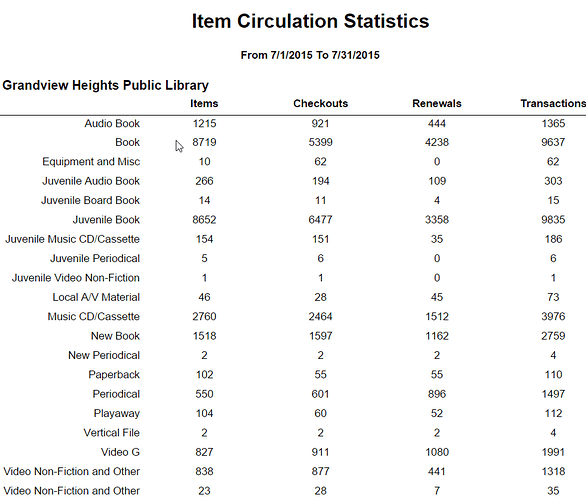Item Circulation Statistics
Circulation > Item Circulation Statistics
Shows branch level circulation by material type within specific date range.
Checkouts + renewals = transactions
The items column shows how many barcodes had either a checkout or renewal on them. The number of items will always be less than or equal to the number of transactions.
For example, if you had one item that was checked out once and renewed twice, then the columns would be items = 1, checkouts =1, renewals=2, transactions=3.
Why does the “Grand Total” section display a smaller amount of items compared to when I manually add the total items separated by material type. Why are the two totals different?
This report looks within the Polaris Transactions database to come up with the results. The Polaris Transactions database acts like a running receipt in chronological order of circulation transactions conducted within Polaris. The Item Circulation Statistics report counts the number of items that have circulated, and groups the items by the cataloged material type at the time of circulation. The “Total for Organization” and “Grand Total” sections then count the number of distinct items within the catalog that have circulated, rather than the sum of the item counts for each material type.
The difference between the number of items by material type and the total number of items, is that the number of items by material type is based upon the material type at the time of circulation. It is possible to change the material type of an item between circulations, which would then count the item twice; once for each material type. While the total number of items is a strict count of individual items that have circulated regardless of it’s material type.
For example:
Harry Potter is first cataloged with a material type of “Fiction”. The book circulates a few times, and is re-cataloged to be “YS - Fiction”, then circulates more. Based upon how the Item Circulation Statistics report is created the Harry Potter item will be counted once for number of “Fiction” items circulated, and again for number of “YS - Fiction” that have circulated. However, when calculating the total number of items circulated that Harry Potter item will only count as 1 for the grand total, even though it is showing up in both the totals for “Fiction” and “YS - Fiction”.
Another way to display the example is through how it would look in the Item Circulation Report:
Fiction 1
YS - Fiction 1
Total For Organization 1
